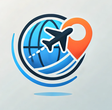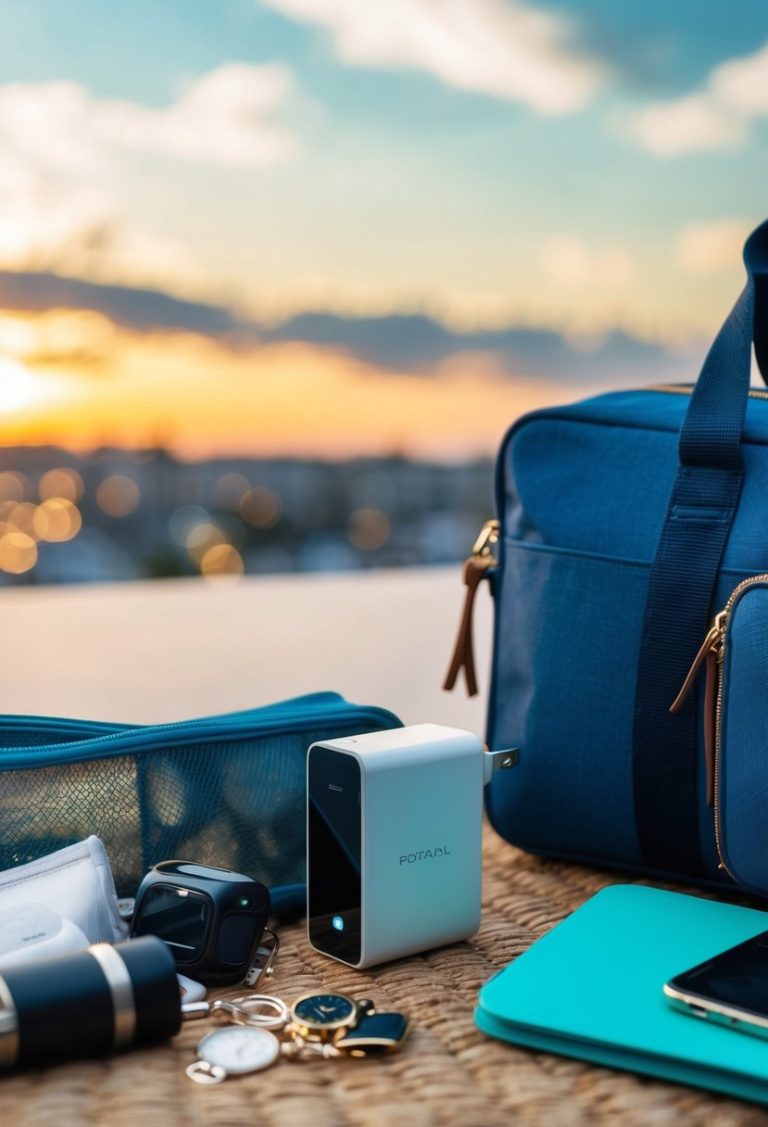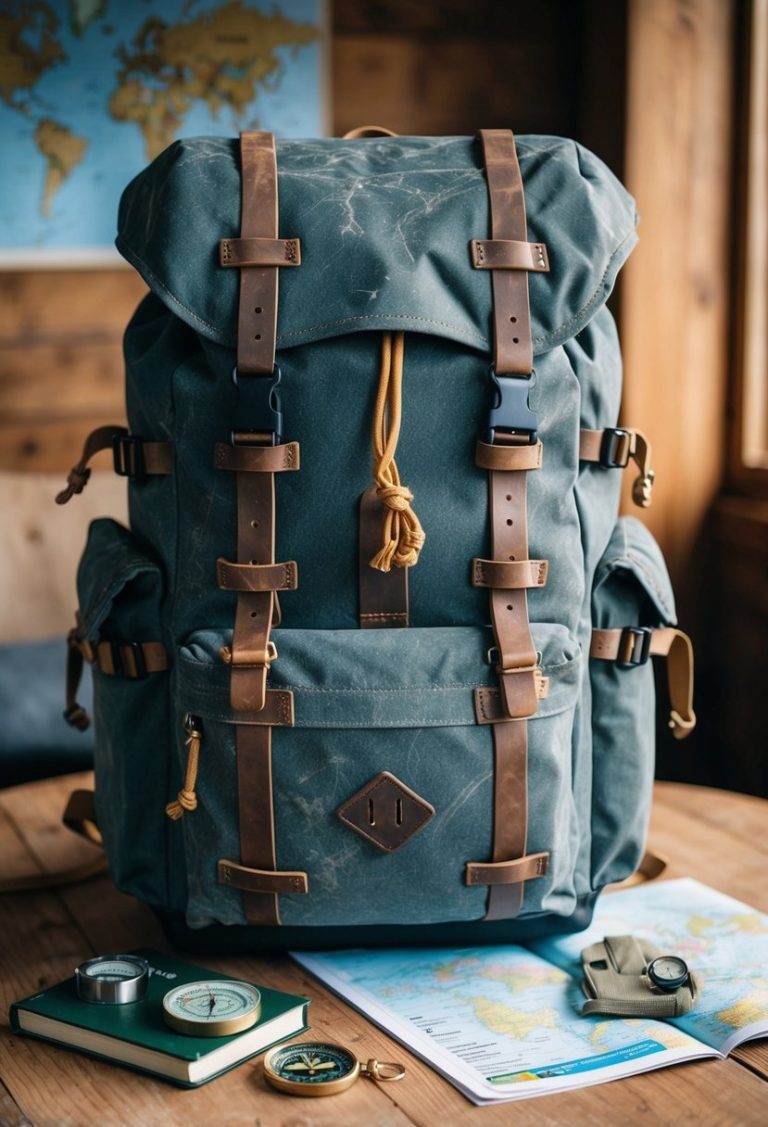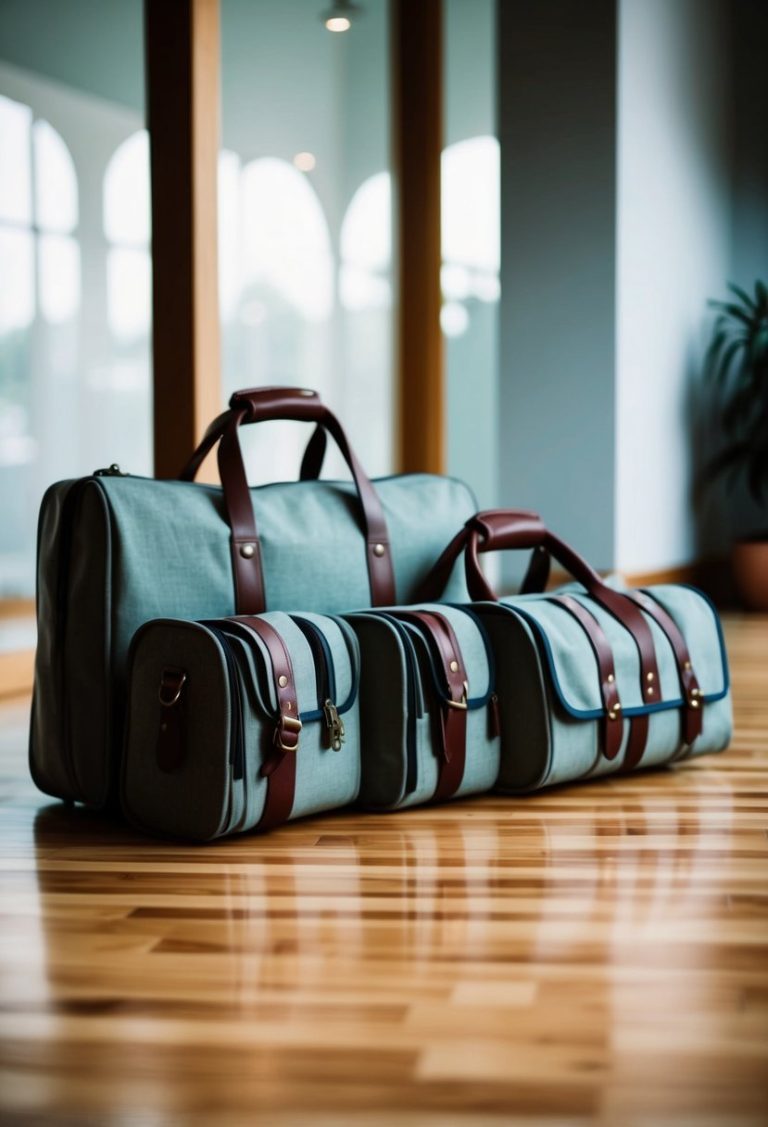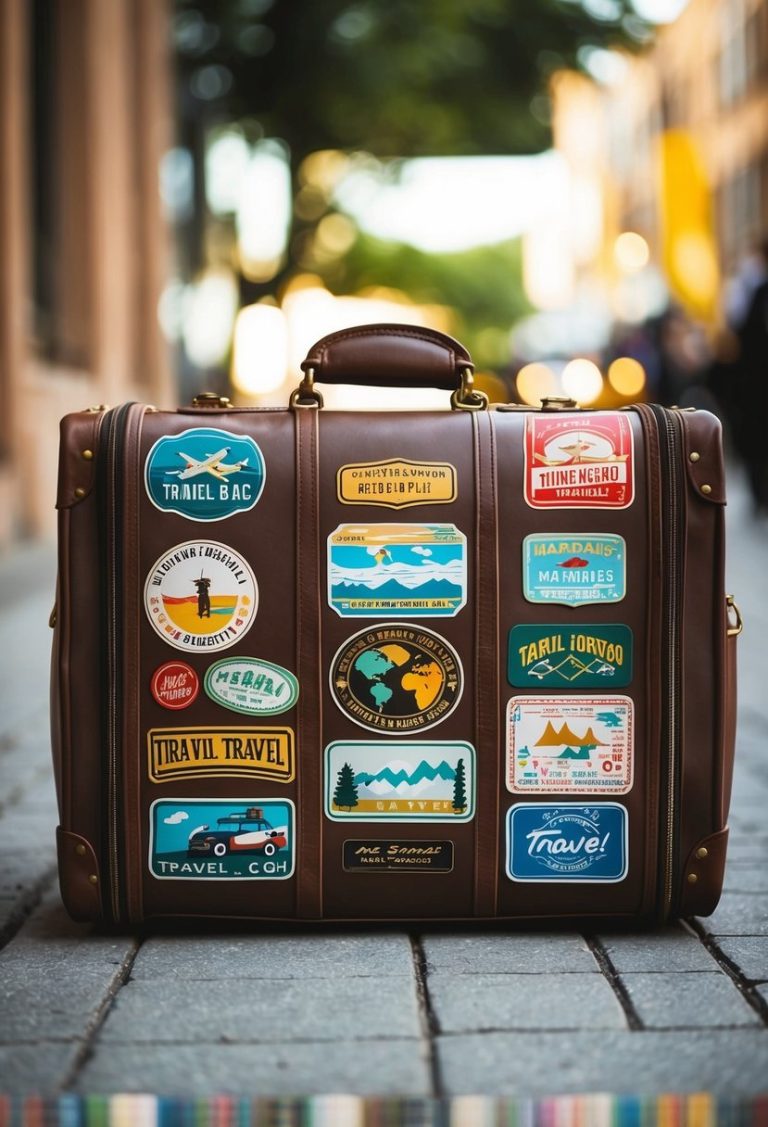When traveling, having a well-prepared emergency bag can make a significant difference during unexpected situations. A traveling emergency bag should include essential items like a first aid kit, water, non-perishable food, and tools for communication and navigation. These supplies can help ensure safety and comfort in case of delays, natural disasters, or other emergencies.

Many travelers underestimate the importance of being ready for the unexpected. With a little planning, anyone can create a bag that fits their needs, whether they are heading to a remote area or visiting a bustling city. This bag can be a lifesaver, offering peace of mind and readiness for whatever may come.
By following some practical guidelines, anyone can easily equip their traveling emergency bag. Learning which items are crucial and how to efficiently pack them can lead to a more enjoyable and worry-free journey.
Importance of a Traveling Emergency Bag

Having a traveling emergency bag is essential for anyone who travels. It provides the necessary items to handle unexpected situations. This preparedness can significantly impact safety and well-being.
Risk Assessment for Various Destinations
Every travel destination poses unique risks. Understanding these risks allows for better preparation. For instance, traveling to areas prone to natural disasters requires specific supplies.
Travelers heading to remote locations should consider items like a compass, first aid supplies, and water purification tablets. In urban settings, personal safety items such as whistles and pepper spray might be more relevant.
Researchers recommend assessing safety data and local conditions before traveling. This assessment may include checking local health issues, weather patterns, and political stability. A well-prepared bag reflects awareness of these risks.
Understanding Basic Human Needs
In emergencies, basic human needs must be met. These needs include food, water, shelter, and first aid. Travelers should plan their emergency bags with these essentials in mind.
A good emergency bag should contain:
- Water: Enough for at least three days. Hydration is crucial.
- Food: Non-perishable items like energy bars or dried fruit.
- Shelter: Items like emergency blankets or tarps provide protection from the elements.
- First Aid Supplies: Band-aids, antiseptics, and any personal medications.
Carefully selected items can make a significant difference in stressful situations. Each component of the emergency bag plays a crucial role in meeting these essential needs.
Essentials for Survival

When preparing a traveling emergency bag, certain items are crucial for survival. This section details essential components that ensure safety and comfort during unexpected situations.
Water Purification Methods
Access to clean water is vital in an emergency. There are several effective water purification methods that one can include in a traveling emergency bag.
- Water Filters: Compact filters can remove bacteria and protozoa. They are lightweight and easy to use.
- Chemical Treatments: Tablets containing iodine or chlorine can purify water. These tablets are small and have a long shelf life.
- Boiling: Boiling water for at least one minute kills most pathogens. A portable stove can assist in this process.
- UV Light Purifiers: These devices use ultraviolet light to kill harmful microorganisms. They are quick, but require battery power.
These methods can help travelers stay hydrated and safe.
Emergency Food Supplies
Including emergency food supplies is essential for long trips. Food should be lightweight, non-perishable, and easy to prepare.
- Energy Bars: These provide quick calories and essential nutrients. They are easy to pack.
- Dehydrated Meals: Just add water to these meals, and they are ready to eat. They are lightweight and keep well.
- Canned Foods: While heavier, they are a good source of protein. Foods like tuna or beans are excellent choices.
- Trail Mix: A mix of nuts, dried fruits, and seeds offers energy and is easy to carry.
These items ensure that travelers have food options available when needed.
First Aid Kit Components
A well-stocked first aid kit is crucial for any emergency bag. Key components include supplies to treat injuries and illnesses.
- Adhesive Bandages: Various sizes should be included for minor cuts.
- Gauze and Tape: These are essential for larger wounds. Sterile gauze pads help stop bleeding.
- Antiseptic Wipes: These can clean wounds to prevent infection.
- Pain Relievers: Basic pain medication like ibuprofen can help with discomfort.
- Emergency Blanket: A compact space blanket retains body heat and protects from shock.
Having these supplies ready can make a significant difference in emergencies.
Shelter and Comfort

When traveling with an emergency bag, shelter and comfort are crucial. Having the right portable shelters and ensuring proper insulation help maintain safety and warmth. Personal hygiene items are also important for health and morale during times of distress.
Portable Shelters
Portable shelters are essential for protection against the elements. Options include tents, tarps, and emergency bivy bags. Tents offer space and security, while tarps are versatile for various setups. Emergency bivy bags are compact and lightweight, making them ideal for quick deployment.
A good bivy bag, like the Survival Frog Tact Bivvy 2.0, is waterproof and reusable. It is crucial to choose a product that is easy to pack and quick to set up. Reliable shelters provide mental security and comfort in emergency situations.
Insulation and Temperature Control
Insulation is vital for keeping warm in cold settings. Emergency sleeping bags are useful here. They retain body heat and reduce the risk of hypothermia. Choosing options with reflective liners can increase warmth significantly.
Adding materials like emergency blankets or insulated liners provides extra protection. These items are lightweight and pack easily, enhancing the comfort of the shelter. For temperature control, it is also important to choose the right location. Avoiding damp areas and finding natural windbreaks can maintain warmth inside the shelter.
Personal Hygiene Items
Personal hygiene items play a significant role in maintaining health. Keeping clean helps prevent infections and boosts morale. Essential items include wet wipes, hand sanitizer, and biodegradable soap.
Having a small toiletry kit can make a difference. Items like toothbrushes and toothpaste can provide comfort during difficult times. Sanitation bags for waste disposal are also crucial. They ensure a clean environment, even in emergency situations. Proper hygiene contributes to overall well-being and helps individuals feel more secure.
Navigation and Communication Tools
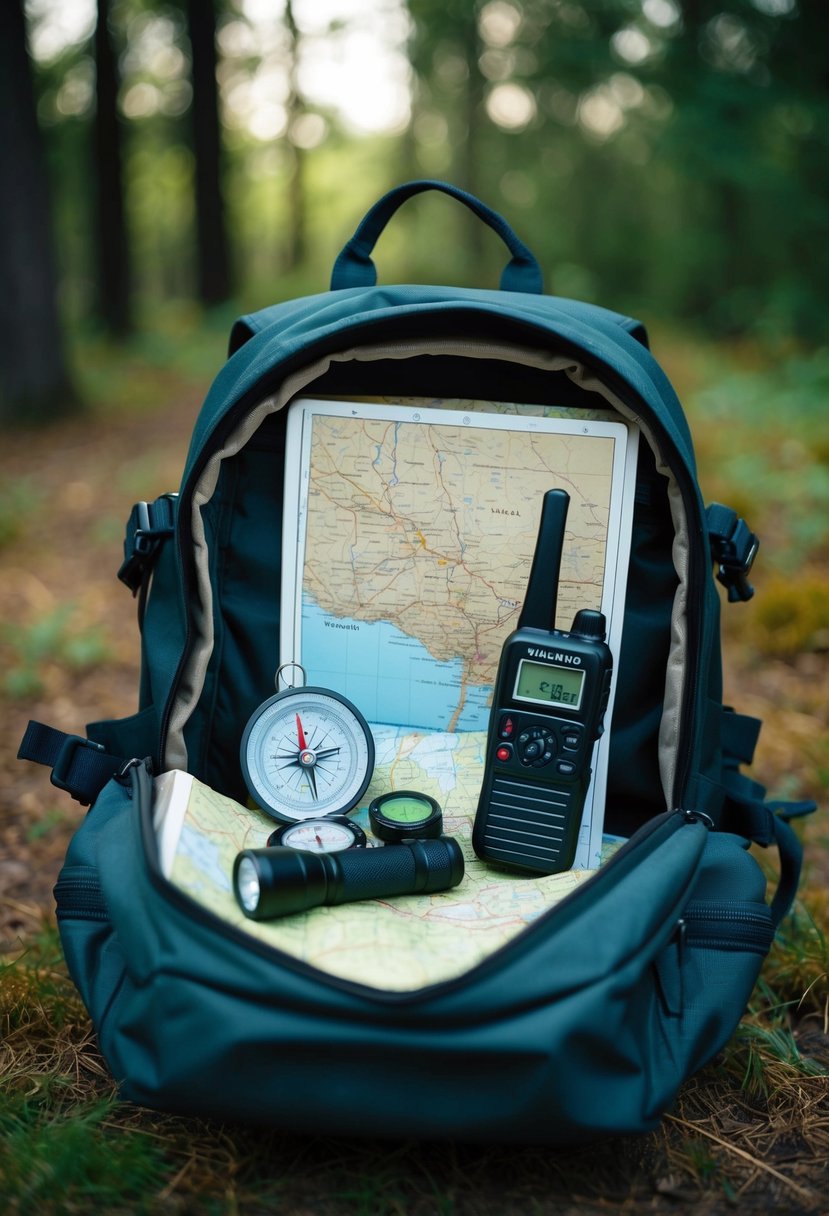
Having the right navigation and communication tools is crucial when traveling. These items help ensure safety, aid in finding one’s way, and maintain contact in emergencies. The following sections will detail essential tools for navigation and communication.
Maps and Compass
Maps and compasses are fundamental navigation tools. A physical map provides a reliable reference, especially when electronic devices fail. It’s important to choose maps that cover the specific areas of travel.
A compass complements the map by helping to determine direction. Modern smartphones can act as GPS units, but they rely on batteries and signals, which may not always be available. A good field compass is lightweight, durable, and easy to use.
Tips for using maps and a compass:
- Practice before the trip. Familiarity with these tools boosts confidence.
- Check landmarks and routes regularly to stay oriented.
- Pack a waterproof map case to protect against weather conditions.
Satellite Phones and Chargers
Satellite phones provide reliable communication in remote areas where standard cell service is unavailable. They operate directly with satellites, making them effective at transmitting messages over vast distances.
Travelers should consider a phone that offers long battery life and can function well in extreme conditions. Portable chargers or solar chargers are also essential to keep the devices powered during extended trips.
Important features to look for:
- Global coverage: Ensure the phone operates worldwide.
- Durable design: A rugged handset withstands harsh environments.
- Prepaid plans: Many satellite phones offer flexible payment options for travelers.
Emergency Signaling Devices
Emergency signaling devices play a vital role in ensuring safety during unexpected situations. These tools allow a traveler to signal for help efficiently. Options include whistles, flares, and signal mirrors.
A whistle is lightweight and can be heard from far away, making it an excellent choice for alerting nearby hikers. Flares can signal emergency situations and are visible from long distances, especially at night.
A signal mirror reflects sunlight and can attract attention over great distances. Carrying one or more of these devices increases the chances of being rescued.
Checklist for emergency devices:
- Carry a whistle for noise signaling.
- Pack flares for visible alerts.
- Include a signal mirror for daytime visibility.
Clothing and Protective Gear

Having the right clothing and protective gear is crucial when preparing a traveling emergency bag. These items can help manage different weather conditions, protect against injuries, and ensure comfort during unexpected situations.
All-Weather Clothing
All-weather clothing should be breathable, lightweight, and water-resistant. It is important to pack moisture-wicking base layers, which help keep the skin dry. A mid-layer, such as a fleece jacket, provides insulation, while an outer layer should be a waterproof and wind-resistant jacket.
Consider including:
- Rain Gear: A compact poncho or rain jacket.
- Thermal Layers: To maintain warmth in cold conditions.
- Convertible Pants: These can be adjusted based on temperature.
Selecting clothing made from synthetic materials or merino wool ensures durability and comfort. Extra clothing should be packed in sealed bags to keep it dry.
Footwear for Different Terrains
Footwear must be suitable for various terrains and weather conditions. Sturdy hiking boots provide support and protection on rugged paths. For lighter trails, trail runners might be preferable due to their comfort and flexibility.
Key features to consider in footwear include:
- Waterproofing: Essential for wet conditions.
- Traction: A good outsole is crucial for stability.
- Fit and Support: Proper fitting boots prevent blisters and discomfort.
It’s wise to pack an extra pair of socks and lightweight sandals for resting. This combination ensures readiness for diverse environments and various activities.
Personal Protective Equipment
Personal protective equipment (PPE) is vital for safety in emergencies. First, a pair of durable gloves protects hands from cuts and scrapes. They are essential when handling tools or debris.
Other important PPE items include:
- Pollution Masks: Protect against dust and harmful particles.
- Safety Glasses: Shield eyes from debris and harsh environments.
- Knee and Elbow Pads: Useful for physically demanding tasks or activities.
Investing in quality protective gear enhances personal safety during unforeseen events, ensuring readiness for a variety of situations.
Technical Supplies and Tools

When preparing a traveling emergency bag, technical supplies and tools play a key role in ensuring safety and readiness. Including the right items can help handle unexpected situations effectively and efficiently.
Multipurpose Tools
Multipurpose tools are essential for any emergency bag. They can serve various functions, from cutting and opening cans to repairing equipment. A good multipurpose tool often includes:
- Knife Blade: Useful for cutting rope or food.
- Screwdriver: Helps with minor repairs.
- Pliers: Ideal for gripping or bending materials.
- Scissors: Effective for various tasks, including cutting bandages.
Selecting a high-quality, durable tool can make a significant difference in stressful situations. Brands like Leatherman or Swiss Army offer reliable options. Having a multipurpose tool can reduce the number of individual items needed, making the bag lighter and more organized.
Repair Kits and Items
Including repair kits in an emergency bag ensures that minor problems can be dealt with quickly. Key components of a repair kit should include:
- Duct Tape: Versatile for quick fixes on gear.
- Zip Ties: Useful for securing loose items or quick repairs.
- Sewing Kit: Essential for mending clothing or gear.
- Small Wrenches: Helpful for adjusting equipment.
A repair kit should be tailored to the specific types of equipment one might have while traveling. This ensures that if something breaks, help is close at hand.
Fire Starting Equipment
Fire starting equipment is critical for warmth, cooking, and signaling for help. Essential items should include:
- Waterproof Matches: Reliable in wet conditions.
- Lighter: Easy to use and effective.
- Fire Starter: Such as magnesium blocks or fire starter sticks for simpler ignition.
- Tinder: Dry leaves or cotton balls to help start a fire quickly.
Ensuring these items are packed and easily accessible can save time in emergencies. Fire is one of the most important resources in survival situations, making its reliable ignition crucial.
Personal Documents and Currency

When traveling, it’s essential to have the right personal documents and sufficient currency. These items ensure smoother travel and provide security during emergencies. Proper preparation helps avoid complications in new environments.
Identification and Travel Documents
Travelers should gather essential identification and travel documents before departure. Important items include:
- Passport: This is a primary identification document needed for international travel.
- Visa: Some countries require a visa for entry, which must be obtained beforehand.
- Driver’s License: Useful for identification and renting vehicles.
- Medical Insurance Card: Provides access to healthcare services abroad.
Copies of these documents should be made. Keep copies in a separate location from the originals. Storing documents in a waterproof pouch is advisable to prevent damage. Digital copies stored in secure cloud storage can provide backup access if physical copies are lost.
Emergency Cash and Backup Credit Cards
Packing emergency cash is vital for unexpected situations, especially where electronic payment methods may not work. Travelers should:
- Carry local currency: This is essential for small purchases and places that do not accept cards.
- Hold backup credit cards: Having multiple cards can help in case one is lost or stolen.
It’s also wise to keep cash in various amounts to make transactions easier. Packing a combination of small bills and coins helps avoid confusion. Travelers can also consider storing cash in safe spots, like a money belt or hidden pouch. Accessing emergency funds can provide peace of mind during travel.
Mental Well-being and Entertainment

Maintaining mental well-being during travel is essential, especially in emergencies. To support this, travelers should pack stress-relief items and compact leisure activities. These elements can help individuals manage anxiety and boredom while on the go.
Stress-Relief Items
Stress-relief items are vital for coping with the uncertainties of travel. They provide comfort and a sense of normalcy in chaotic situations. Some effective options include:
- Fidget Toys: Small, portable toys can help relieve stress and keep hands busy.
- Meditation Apps: Downloading apps on a smartphone can provide guided meditation and relaxation exercises.
- Essential Oils: A small bottle of calming scents like lavender can be soothing and promote relaxation.
- Comforting Snacks: Packing favorite snacks can boost mood and provide a sense of comfort.
Including these items in an emergency bag ensures that individuals have tools to help manage stress effectively.
Compact Leisure Activities
Compact leisure activities offer a way to unwind and entertain the mind. They are easy to pack and can provide a welcome distraction from stressful situations. Consider these options:
- Travel-sized Games: Card games or mini board games are great choices for social interaction and fun.
- Books or E-Readers: A good book or e-reader loaded with favorite titles can transport anyone away from stress.
- Adult Coloring Books: These allow for creative expression while promoting relaxation. Pack a small set of colored pencils or markers.
- Puzzle Books: Crossword puzzles or Sudoku can engage the mind and provide hours of entertainment.
Having these leisure activities on hand can enhance mental well-being and make unexpected waiting times more enjoyable.
Training and Knowledge Resources

Having the right training and knowledge can make a significant difference in emergencies. Understanding first aid and local customs enhances preparedness for unexpected situations.
First-Aid and Survival Guides
First-aid and survival guides are essential for anyone traveling. They provide detailed instructions on how to handle injuries and emergencies. A comprehensive guide should include the following topics:
- Basic First Aid: How to treat cuts, burns, bites, and fractures.
- CPR Techniques: Steps to perform cardiopulmonary resuscitation.
- Wound Care: Best practices for cleaning and dressing wounds.
- Survival Skills: Navigation, shelter building, and water purification.
Travelers should keep a physical copy of these guides stored in their emergency bag. Digital versions are useful, but they rely on battery life and signal strength. For more tailored knowledge, consider workshops or online courses in first aid.
Local Customs and Language Tips
Understanding local customs and language is vital for effective communication and building rapport. Key areas to focus on include:
- Basic Phrases: Learning greetings and essential questions in the local language.
- Cultural Norms: Familiarizing oneself with local etiquette, such as greetings, gestures, and dining customs.
- Emergency Contacts: Knowing how to ask for help in the local language can save time during a crisis.
Travelers can find resources online or in guidebooks that provide cultural insights. Attending local classes or using language learning apps can also improve skills before the trip. This knowledge minimizes misunderstandings and enhances safety abroad.
Maintaining Your Emergency Bag

Regular maintenance of an emergency bag is essential for its effectiveness. This ensures that the contents remain usable and ready for any situation.
Check Expiration Dates:\
Items like food, medicine, and batteries can expire. He should review these regularly and replace any expired items.
Inspect Equipment:\
Regularly verify that tools, flashlights, and other equipment are functional. If something is broken or missing, it should be replaced promptly.
Storage Conditions:\
It is important to store the bag in a cool, dry place. Avoid areas that might be exposed to moisture, heat, or pests.
Update Contents:\
As seasons change, so do needs. They should update their emergency bag to include items suited for current weather or travel conditions.
Keep a Checklist:\
Maintaining a checklist of items is beneficial. He can use it to ensure that everything is accounted for at each maintenance check. This helps prevent forgetfulness and keeps the bag organized.
Practice Accessibility:\
Everyone should know where the emergency bag is kept. Ensure it is stored in an easily accessible location, especially in case of an emergency.
Customizing Your Bag for Specific Trips

Customizing a travel emergency bag is essential for preparedness. The contents should match the destination, climate, and personal needs.
Type of Travel\
Here are some scenarios to consider:
- Urban Travel: Include items like a portable phone charger, personal alarm, and water bottle.
- Wilderness Adventures: Pack first aid supplies, a fire starter, and water purification tablets.
- International Travel: Add copies of important documents and a universal adapter.
Weather Considerations\
Weather also plays a significant role. Include:
- Hot Climate: Sunscreen, a hat, and insect repellent.
- Cold Climate: Warm clothing, hand warmers, and a space blanket.
Duration of Trip\
The length of the trip affects what to pack.
- Short Trips (1-2 days): Focus on essentials like snacks, a flashlight, and a multi-tool.
- Extended Trips: Consider more food supplies, extra clothing, and personal hygiene items.
Personal Needs\
Individuals should consider their unique requirements.
- Medications: Always pack enough for the duration of the trip.
- Childcare: Bring snacks, toys, and any necessary baby supplies.
By considering these factors, travelers can ensure their emergency bag is well-prepared for specific trips.
